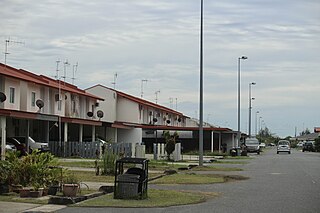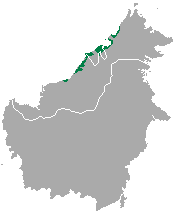
Bandar Seri Begawan is the capital and largest city of Brunei. It is officially a municipal area with an area of 100.36 square kilometres (38.75 sq mi) and an estimated population of 100,700 as of 2007. It is part of Brunei-Muara District, the smallest yet most populous district which is home to over 70 per cent of the country's population. It is the country's largest urban centre and nominally the country's only city. The capital is home to Brunei's seat of government, as well as a commercial and cultural centre. It was formerly known as Brunei Town until it was renamed in 1970 in honour of Sultan Omar Ali Saifuddien III, the 28th Sultan of Brunei and the father of the current Sultan Hassanal Bolkiah.

A village head, village headman or village chief is the community leader of a village or a small town.
A mukim is a type of administrative division used in Brunei, Indonesia, Malaysia and Singapore. The word mukim is a loanword in English. However, it was also originally a loanword in Malay from the Arabic word: مقيم. The closest English translation for mukim is township.
The administrative divisions of Brunei mainly consist of daerah (districts), mukim (subdistricts) and kampung or kampong (villages). They are organised hierarchically, with daerah being the first level and kampong the third level.

Panaga is a coastal settlement on the north-east coast of the island of Borneo, in the Bruneian district of Belait. Officially known as Kampong Panaga, it is a village-level subdivision under Seria, a mukim or subdistrict of Belait. The settlement of Panaga comprises a public housing estate under the National Housing Scheme and the housing estate of Brunei Shell Petroleum (BSP), the main oil and gas company in the country. Panaga is also home to the headquarters of the company itself. The postcode for Panaga is KB4533.

Kampong Mumong or simply known as Mumong, is a residential suburb of Kuala Belait, the principal town of Belait District, Brunei. It comprises the original Mumong settlement, as well as the Mumong public housing estate of the Landless Indigenous Citizens' Housing Scheme. However, it officially consists of two village subdivisions, namely Mumong 'A' and Mumong 'B', which are under the mukim of Kuala Belait.

Mukim Labi is a mukim in the interior of Belait District, Brunei. It has an area of 361.8 square kilometres (139.7 sq mi); the population was 1,216 in 2016.

Mukim Berakas 'A' is a mukim in Brunei-Muara District, Brunei. The population was 27,223 in 2016.

Mukim Burong Pingai Ayer is a mukim in Brunei-Muara District, Brunei. It is located within Kampong Ayer, the traditional stilt settlements on the Brunei River in the capital Bandar Seri Begawan. The population was 1,770 in 2016.

Mukim Melilas is a mukim in Belait District, Brunei. The population was 29 in 2016, the least populous mukim in all of Brunei. It is considered the final and most isolated settlement in Belait, and maybe all of Brunei.

Mukim Bangar is a mukim in Temburong District, Brunei. It has a total area of 113 square kilometres (44 sq mi); the population was 2,112 in 2021. The mukim encompasses Bangar, the district's sole town and administrative centre.

The Brunei Malay language, also called Bruneian Malay language, is the most widely spoken language in Brunei and a lingua franca in some parts of Sarawak and Sabah, such as Labuan, Limbang, Lawas, Sipitang and Papar. Though Standard Malay is promoted as the official national language of Brunei, Brunei Malay is socially dominant and it is currently replacing the minority languages of Brunei, including the Dusun and Tutong languages, existing in a diglossic speech, wherein Brunei Malay is commonly used for daily communication, coexisting with the aforementioned regional languages and Malay creoles, and standard Malay used in formal speech; code switching between standard Malay and Brunei Malay is spoken in informal speech as a lingua franca between Malay creoles and regional languages. It is quite similar to Standard Malay to the point of being almost mutually intelligible with it, being about 84% cognate with standard Malay. Standard Malay is usually spoken with Brunei pronunciation.

Kampong Lumut or commonly known as Lumut, is a coastal settlement in Belait District, Brunei, about 30 kilometres (19 mi) from the district town Kuala Belait. The total population was 11,273 in 2016.
A kampong is the term for a village in Brunei, Indonesia, Malaysia and Singapore and a "dock" in Cambodia. The term applies to traditional villages, especially of the indigenous people, and has also been used to refer to urban slum areas and enclosed developments and neighbourhoods within towns and cities in Brunei, Indonesia, Malaysia, Singapore, Cambodia, Sri Lanka and Christmas Island. The traditional kampong village designs and architecture have been targeted for reform by urbanists and modernists and have also been adapted by contemporary architects for various projects.

Kampong Pandan or simply known as Pandan, is a residential area in Kuala Belait, the principal town of Belait District, Brunei. It has a population of around 16,200 in 2016. It encompasses a housing estate of the country's National Housing Scheme.

Kampong Bukit Beruang, also simply known as Bukit Beruang, is a village in Tutong District, Brunei, about 13 kilometres (8.1 mi) from the district town Pekan Tutong. The population was 6,157 in 2016. It is one of the villages within Mukim Telisai, a mukim subdivision in the district. It comprises the original village settlement as well as the public housing estate Bukit Beruang National Housing Scheme.

Kampong Telisai, also simply known as Telisai, is a coastal village in Tutong District, Brunei, about 17 kilometres (11 mi) from the district town Pekan Tutong. The village also encompasses the public housing area STKRJ Kampong Telisai. The population was 2,293 in 2016. It is one of the villages within Mukim Telisai. The postcode is TC1145.

Kampong Danau, simply known as Danau, is a coastal village in Tutong District, Brunei, about 21 kilometres (13 mi) from the district town Pekan Tutong. It has a total area of 6.5023 square kilometres (2.5106 sq mi); the total population was 1,072 in 2016. It is one of the villages within Mukim Telisai.

Kampong Bukit Panggal is a village in Tutong District, Brunei, about 10 kilometres (6.2 mi) from the district town Pekan Tutong. The population was 801 in 2016. It is one of the villages within Mukim Keriam, a mukim in the district.

Kampong Batu Apoi is a village in Temburong District, Brunei, about 5 kilometres (3.1 mi) East from the district town Bangar. The population was 84 in 2021. It is one of the villages within Mukim Batu Apoi. The postcode is PC1151.

















